Moto X Style vs Moto X (2014): What’s new?
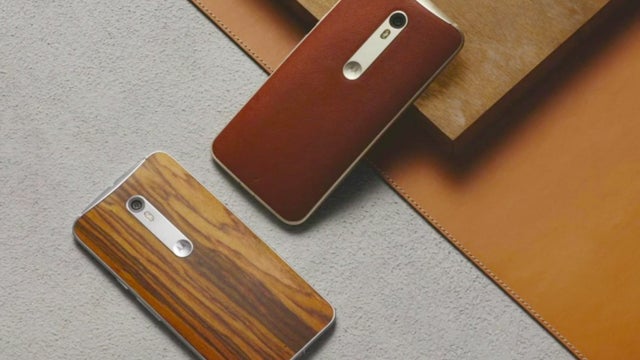
Moto X Style vs Moto X 2014: Should you be getting ready to upgrade?
Motorola has unleashed its latest slew of phones for 2015. There’s the Moto G (2015), a brand-new Moto X Play and of course, the headline act itself, the Moto X Style.
As big fans of the of the Moto X (2014), we’re certainly excited about what Motorola has in store for the series. But what exactly has changed? Let’s compare the specs and see.
The Moto X Style is ‘the fastest charging phone ever’
We’ve had Quick Charge technology for a while now and it makes powering phones back up like the Samsung Galaxy S6 and LG G4 so much quicker than standard charging. Now Motorola is taking things one step further. The Moto X Style comes with a new feature called Turbo Power, and if it lives up to its billing, it’ll be one of the standout features.
Related: Moto G 3 vs Moto G 2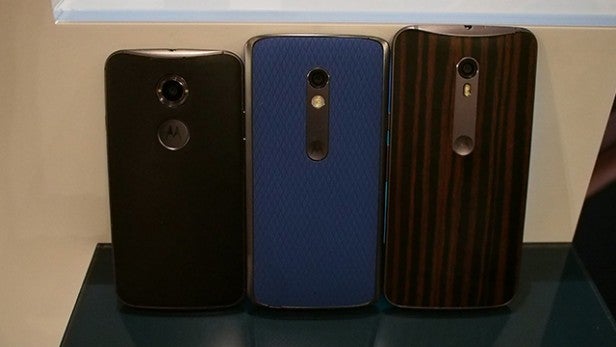 Left to right: Moto X (2014), Moto X Play and Moto X Style
Left to right: Moto X (2014), Moto X Play and Moto X Style
During its unveiling, Motorola pitched the Style charging directly against the Galaxy S6 and it managed to outclass it. Whether it’ll be the same in real world use is another matter. Fifteen minutes worth of charging should give you 10 hours of use. We really hope it can deliver on those impressive claims.
But, great battery charging tech is nothing if the phone can’t last past lunchtime. Keeping the style chugging along is a 3,000mAh battery, that’s much bigger than the 2,300 mAh version from the Moto X (2014). It does of course have a bigger, higher resolution display to power. The real battery life king seems to be the Moto Play, which has a huge 3,630 mAh battery.
A recognisable design
You might be hard pushed to spot the difference between the Moto X Style and the Moto X (2014). Aside from the size increase, the general look is still pretty much the same. Both have speaker grilles above and below the display, and both have a slight curve on the back. It’s a sleek, yet simple, design that we think looks great.
Related: One Plus 2 vs One Plus One: What’s new?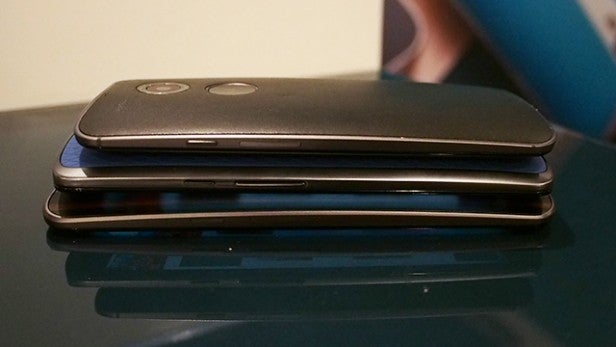 Top to bottom: Moto X (2014), Moto X Play and Moto X Style
Top to bottom: Moto X (2014), Moto X Play and Moto X Style
Dimensions wise, the Moto X Style comes in at 153.6 x 76.2 x 11.06mm. It’s also just 6.1mm at its thinnest point. Last year’s Moto X was a much more compact device, measuring 140.8 x 72.4 x 10mm. It’s also a lot lighter, tipping the scales at 144g as opposed to the 179g the Moto X Style weigh in at.
Bigger screen, better resolution
There wasn’t anything really wrong with the 5.2-inch display on the Moto X (2014). It was a Full HD 1080p resolution scren with good colour reproduction and had great viewing angles. Some said it was a little on the pinkish side, but that wasn’t something that had us clamouring for an update.
The Style though ups the stakes in a number of areas. First off it’s much bigger, at 5.7-inches. That’s right in phablet territory and pecking at the heels of the Samsung Galaxy Note 4 (and upcoming Note 5). However, it’s actually just about as compact as the 5.5-inch display toting iPhone 6 Plus due to its 76% body to screen ratio.
Related: Moto X Style vs Moto X Play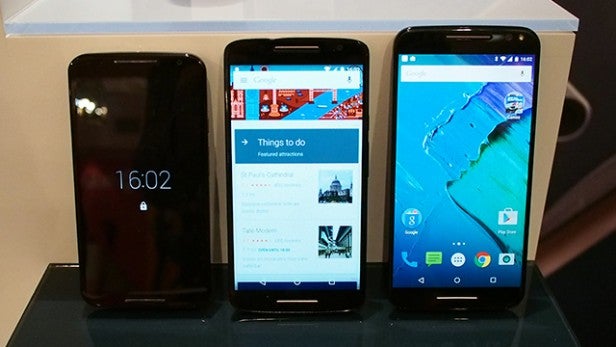 Left to right: Moto X (2014), Moto X Play and Moto X Style
Left to right: Moto X (2014), Moto X Play and Moto X Style
Motorola has also upped the resolution, taking the step from 1080p to Quad HD. While QHD screens are becoming the norm for high-end handsets, we haven’t been completely sold on whether or not it’s worth the battery hit.
Could this finally end Moto’s camera woes?
Motorola has struggled in the past with its cameras. The original Moto X’s camera underwhelmed and while the 2014 edition was a marked improvement, it still lagged quite far behind the competition. With the Android camera space ever improving, the Style really needs to impress.
Well, at least Motorola is confident about it. The company has claimed the Style has a ‘best in class’ camera and one that would ‘guarantee your photos will look better’. Those are big words, and we really hope they’re true.
Related: Moto E 2 vs Moto G 2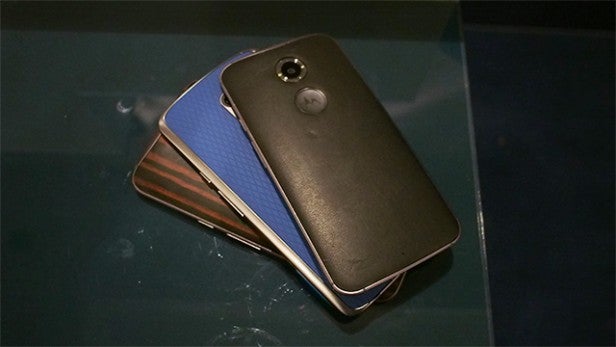 Top to bottom: Moto X (2014), Moto X Play and Moto X Style
Top to bottom: Moto X (2014), Moto X Play and Moto X Style
Let’s take a look at the specs. The 13-megapixel main sensor from the previous Moto X has been upgraded to a new 21-megapixel sensor complete with f/2.0 aperture. This apparently uses the most advanced camera technologies available. The new camera should let in more light, increase the focus speed and produce more accurate colours. The camera is flanked by a dual CCT flash and it’ll shoot video at 4K at 30fps (plus 1080p at 60fps), if that’s your bag.
Light up those selfles
Continuing the camera theme, Motorola has updated the ever-so-important front facing snapper – or the selfie cam – in a number of ways. It’s upped the resolution to 5MP and added an 87 degree wide angle lens. This will let you cram more background, or friends, into your pictures.
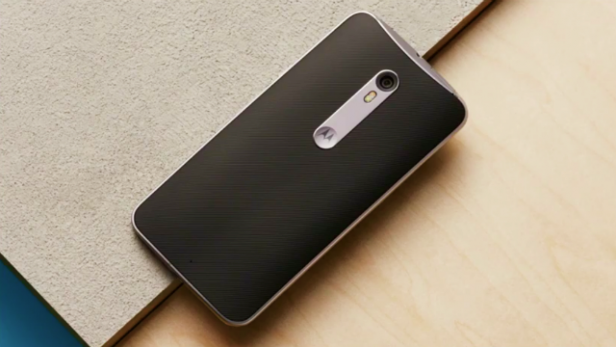
Another new addition is the front-facing flash. This is a bit of a strange one, as smartphones flashes tend to ruin more photos than they improve, but it should add a little more light to your late-night party snaps.
Improved internals
Beefed up internals are par for the course with an updated smartphone, and the Moto X Style doesn’t buck the trend.
A Qualcomm Snapdragon 808, 1.8GHz hexa-core processor replaces the 2014 Moto X’s ageing Snapdragon 801 chip. It worked well in the LG G4, so we’re confident it will perform admirably here and avoids in potential issues by opting against going with the problematic Snapdragon 810 processor.
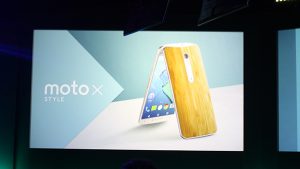
The RAM has been upped from 2GB to 3GB too, so multitasking should be even smoother as well.
Micro SD card support is a welcome addition
It seems that in the year the original advocate for MicroSD support, that’s Samsung, removed it from its flagship device, every other manufacturer has added or kept it in. HTC, LG and Sony have stuck with micro SD support on all of their flagship phones and now the Moto X Style does too.
Last year’s Moto X didn’t have this, so it’s a nice update for those who love to jam their phones with lots of media. It’s also great for recording 4K video, as that chews through space rapidly.
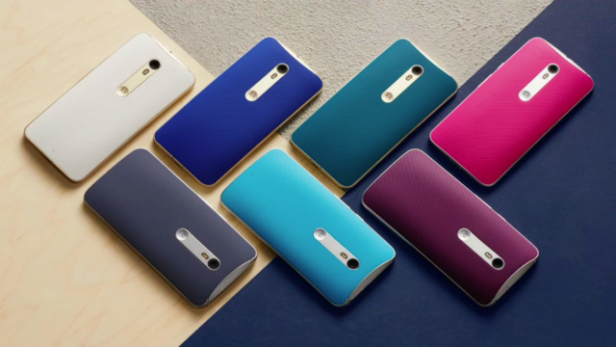
Cards up to 128GB are supported and this will supplement either 16, 32 or 64GB of onboard storage. We’re a bit disappointed to see 16GB sticking around as it’s just not enough these days, but at least it can easily be increased.
Still that stock Android experience
Motorola didn’t really spend a lot of time on the software side of things, except from reiterating that it ships all of its devices without bloatware, skins and the like. Instead, you get a near stock build of Android Lollipop with a couple of enhancements.
These additions are pretty much what we saw on the Moto X (2014), so you’ve got Moto Display for notifications, Moto Voice for hands-free use and Moto Assist for setting up handy IFTT-style action linking.
Related: Android M features we can’t wait to try out 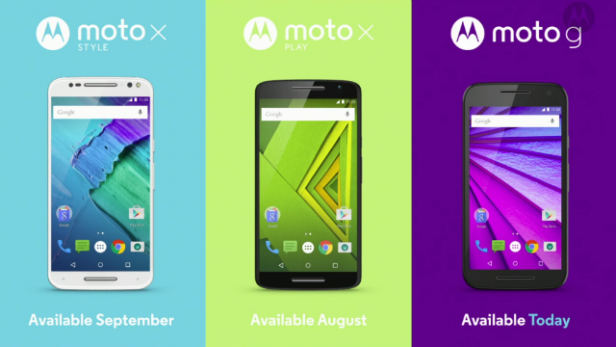
Motorola’s approach to Android is one of the best out there. It’s light, quick and functional, plus you’ll be first in line for software updates including the upcoming Android M.
Early verdict
If you loved the compact nature of the Moto X (2014), we wouldn’t blame you for having reservations about the Moto X Style. But if you’re in the market for a big screen phone that doesn’t have a massive footprint, it could be for you.
We’re keen to see whether Motorola has finally improved its cameras, and the Turbo Power feature certainly sounds useful. We’re less than enthusiastic about the battery though, will it be enough to keep that big, QHD display running all day?
Pricing is an interesting aspect here as well too. The Moto X (2014) cost £420 SIM-free with the new Moto X Style priced in at a more affordable £360. That’s a pretty big reduction of a flagship phone and maintains Motorola’s commitment to offer high end specs in a phone that ‘s cheaper than what its Android rivals currently offer.
Overall we’re excited about Moto’s latest creation and we’re eager to get our hands-on it once it’s available in September.


